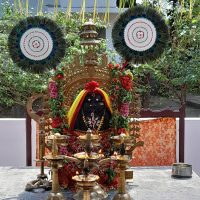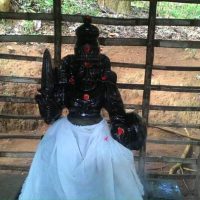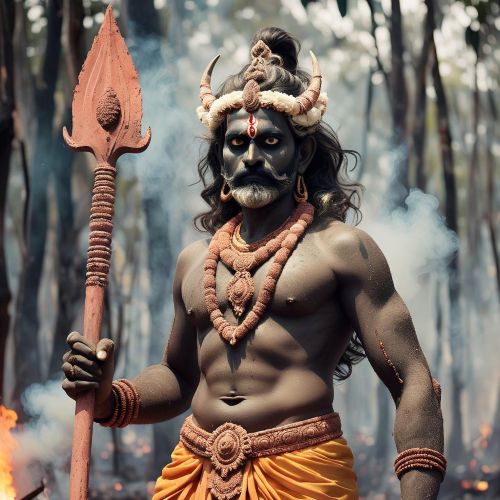Karineeli : The Fierce Yakshi
Listen
At a glance
| Description | |
|---|---|
| Origin | Indian Mythology |
| Classification | Spirits |
| Family Members | Karinkutty (Son) |
| Region | India |
| Associated With | Tantric Practices, Protection |
Karineeli
Introduction
Karineeli, also known as Kalladikode Karineeli, is one of the most enigmatic figures in Kerala’s folklore, deeply rooted in the traditions of the Palakkad region. She belongs to the class of yakshis, supernatural beings often portrayed in South Indian mythology as both alluring and terrifying. Her legend has survived through ritual performances, tantric practices, and oral traditions, making her an enduring symbol of feminine power and mystery.
Unlike benign village deities, Karineeli is remembered for her dual personality—nurturing as a mother figure yet capable of unleashing wrath upon those who offend her. She is strongly associated with the Siruvani forests near Muthikulam village, where locals believe her spirit resides. As a dominant figure in the Shakti school of Tantra, Karineeli holds a unique place as a goddess who embodies both compassion and fury, revered by devotees, feared by evil spirits, and invoked by mantrikas (sorcerers).
Physical Traits
Descriptions of Karineeli emphasize her beauty and terrifying aura in equal measure. In many tales, she appears as a tall woman with flowing black hair, sharp fangs, and glowing eyes that instill fear in those who encounter her. Her long hair is sometimes compared to the dark slopes of the Kalladikode hills, giving her a natural connection to the land.
Karineeli is also said to move through the forests accompanied by wild animals like tigers, elephants, and leopards, who obey her commands. The sound of her anklets is believed to announce her presence, a signal of both danger and divine authority. In ritual performances such as Neeliyattam, her physical traits are dramatized with elaborate costumes, painted faces, and rhythmic movements that capture her fiery spirit.
Family
Karineeli’s mythological connections suggest a strong maternal identity. She is regarded as the mother of Karikutti, her son, who features in folk stories as a fierce companion deity. Some traditions also connect her with Malavayi (Malavazhi), another goddess worshipped in Palakkad, portraying them as divine sisters born through the blessings of Uthithappan, a seer often associated with Lord Shiva.
Legends describe Karineeli giving birth to Karikutti while descending the hills, symbolizing her connection to both fertility and the wilderness. In some narratives, she is also linked with Kunjathol, a mortal companion of lower caste origin, suggesting that her myth reflects not only divine motherhood but also the social realities of Kerala’s past.
Other names
Karineeli is known by several names that vary across regions and traditions. In Malayalam folklore, she is called Karineeliyamma, a reverential form used in ritual worship. In some texts and performances, she is referred to as Cherunili or Kalliyakattu Neeli. In Kannada oral traditions, her name appears as Kari Mara and Karineeli, demonstrating how her legend traveled across linguistic boundaries.
Additionally, in tantric contexts, she is occasionally equated with Karinkali, a fierce aspect of Goddess Kali, highlighting her destructive yet protective qualities. These variations in nomenclature reflect the adaptability of her myth to different cultural settings and belief systems.
Powers and Abilities
The powers attributed to Karineeli are vast, making her one of the most formidable yakshis in Kerala’s lore. She is believed to have received special blessings from Lord Shiva, which endowed her with the ability to control spirits, heal the afflicted, and punish wrongdoers. Her worshippers invoke her for protection against black magic, disease, and wild animals, while sorcerers call upon her in vamachara tantric practices for destructive rituals.
One of the most striking beliefs is that devotees who perform intense midnight rituals at the Muthikulam pond for 18 consecutive days may be granted supernatural powers. However, failure to complete the rites is said to bring madness or possession, emphasizing both the danger and sanctity of her worship.
Karineeli is also famed for her role in exorcism. Sorcerers use her powers to bind malevolent spirits, often symbolically nailing them into trees as part of rituals. She is a goddess of enchantment and terror, a divine force who rewards bravery but devastates those who falter in devotion.
Modern Day Influence
Although Karineeli’s origins lie in ancient myths, her presence continues to resonate in modern Kerala. She remains a central figure in Neeliyattam and Karikuttiyattam, traditional ritual dance-dramas performed by the Paraya community. These performances serve both as acts of worship and as cultural storytelling, preserving her legend for future generations.
In recent years, artists and playwrights have reimagined her myth for contemporary audiences. Theatre productions, such as those directed by Ravi Thycaud, reinterpret her story not as a terrifying spirit but as a powerful representation of feminine energy and marginalized voices. These plays also aim to shed light on the historical struggles of the Paraya community, whose spiritual practices are deeply tied to Karineeli worship.
Beyond performance arts, Karineeli’s legend has found its way into academic studies, literature, and digital storytelling. Her tale is being revived on websites dedicated to folklore, attracting younger audiences fascinated by Kerala’s mystical heritage. The rituals at the Kalladikode hills and Muthikulam pond continue to draw devotees and practitioners of mantrikam, ensuring that her myth remains alive both in sacred spaces and popular imagination.
In modern Kerala, Karineeli is no longer just a figure of fear. She has become a cultural symbol representing the region’s rich mythological traditions, its blend of nature worship and tantric practices, and the enduring strength of feminine divinity.
Related Images
Source
Raman, M. (2020). Ghosts, Monsters, and Demons of India. Blaft Publications. Retrieved from https://www.blaft.com/blogs/news/the-indian-horror-story-on-ghosts-monsters-and-demons-of-india-by-blaft-publications
OnManorama. (2018, October 16). The chilling lore of Kalladikode Karineeli. Retrieved from https://www.onmanorama.com/travel/kerala/2018/10/17/chilling-lore-kalladikode-karineeli.html
Wikipedia. (2023, March 2). Malavazhiyattam. Retrieved from https://en.wikipedia.org/wiki/Malavazhiyattam
New Indian Express. (2018, November 16). About those dark days. Retrieved from https://www.newindianexpress.com/kochi/2018/Nov/16/about-those-dark-days-1899171.html
Vadakkumpuram.in. (2024, March 12). Kalladikodu Karineeli. Retrieved from https://vadakkumpuram.in/kalladikodu-karineeli/
Thiruvananthapuram First. (2025, April 14). Story of a fiery, forest goddess. Retrieved from https://www.thiruvananthapuramfirst.in/?p=8585
UOC Scholar. (n.d.). A theatrical study of Malavaayiaattom. Retrieved from https://scholar.uoc.ac.in/bitstreams/ed5262f1-8ec7-49a0-b7de-18f414f747a4/download
Holy Prasadam. (2025, September 5). Temple details. Retrieved from https://www.holyprasadam.com/temples/details/415
Nair, S. (2008). Yakshi: The Enchantress of the Forest. Sahitya Akademi.
Menon, A. S. (1996). Cultural Heritage of Kerala: An Introduction. Department of Public Relations, Government of Kerala.
Gopalakrishnan, K. (2012). Tantric Traditions in South India. Motilal Banarsidass.
Panikkar, K. N. (1989). Folklore and Rituals in Kerala. Indian Folklore Research Journal, 5(1), 45–60
Frequently Asked Questions
What is lorem Ipsum?
I am text block. Click edit button to change this text. Lorem ipsum dolor sit amet, consectetur adipiscing elit. Ut elit tellus, luctus nec ullamcorper mattis, pulvinar dapibus leo.
What is lorem Ipsum?
I am text block. Click edit button to change this text. Lorem ipsum dolor sit amet, consectetur adipiscing elit. Ut elit tellus, luctus nec ullamcorper mattis, pulvinar dapibus leo.
What is lorem Ipsum?
I am text block. Click edit button to change this text. Lorem ipsum dolor sit amet, consectetur adipiscing elit. Ut elit tellus, luctus nec ullamcorper mattis, pulvinar dapibus leo.
What is lorem Ipsum?
I am text block. Click edit button to change this text. Lorem ipsum dolor sit amet, consectetur adipiscing elit. Ut elit tellus, luctus nec ullamcorper mattis, pulvinar dapibus leo.
What is lorem Ipsum?
I am text block. Click edit button to change this text. Lorem ipsum dolor sit amet, consectetur adipiscing elit. Ut elit tellus, luctus nec ullamcorper mattis, pulvinar dapibus leo.













